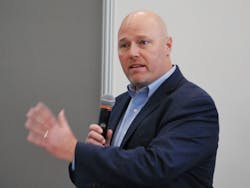What’s the difference between an automated system and an autonomous one? The answer may seem obvious, but the distinctions are many.
An automated system is programmed to perform tasks in the absence of human intervention, while an autonomous system learns to perform tasks and adapts by learning in environments of uncertainty, explained Cyril Perducat, chief technology officer, Rockwell Automation, who spoke privately to the press during Automation Fair in Boston. “Automated systems are programmed, and autonomous systems are learned,” he continued.
Autonomous systems are dynamically adaptable with continuous learning, compared with manually reprogrammed adaptability in an automated system. The differences continue. Data scientists collaborate with engineers in an autonomous system because domain knowledge is combined with a high volume of data. This allows applications in an autonomous system to include multi-variable nonlinear, dynamic practices. Automated systems handle simple linear problems with few variables because they’re limited to first-principles domain knowledge.
The idea of a system that learns and adapts could be at almost any level, said Perducat. “It could be at the equipment level, sensor level, control level, operation-management level or business-planning level,” he explained. “You could be doing condition monitoring of motors.”
The applications of a learning system could be almost anywhere in the manufacturing value chain. “AI and autonomous systems will change the industrial-automation landscape the way autonomous vehicles have changed the automotive landscape,” predicted Perducat. “Customers don’t care if it’s AI. They care more about outcomes.”
Rockwell Automation’s own AI innovations are taking place in five core areas:
• Research and development (R&D) programs that inspire new product innovations—these are focused on the intersection of AI, control theory and operations research.
• AI that supercharges legacy products—this includes added features that enhance product differentiation, performance and pricing opportunities.
• New products made possible by AI—these will include accretive capabilities in the portfolio and the unlocking of new business models.
• AI implementation and managed services—these could include end-to-end technology consulting to deliver digital transformation.
• AI in operations and internal systems—these include the delivery of efficiency in financial systems, supply chain and customer engagement.
Large enterprises are probably further along the AI path than small to mid-size companies, explained Perducat. “The ones that are successful have a real problem to solve and the ability to solve the problem by using the right amount of technology at the right place,” he said. “We need to do AI that is invisible and that can be used by customers who benefit from one more tool.”
High productivity, low cost and reliability have been traditional expectations of end users, but the customer of the future will demand the right product at the right cost at the right time, plus sustainability, agility and resilience in the face of cyber-attacks and supply-chain disruptions, predicted Perducat. Minimal energy consumption will drive sustainability through production choices.
The production systems of the future will include an augmented worker, autonomous operations, integral machine vision, autonomous control and integrated robotics. “Ultimately, this is about augmenting people,” said Perducat. “You are empowered with access to knowledge.”
Intelligent edge devices collect data, and they have the ability to program and re-program, explained Gregory Gernert, Jr., vice president and general manager, motion, Rockwell Automation. Autonomy in the process or between the processes makes them adaptable and resilient. Mobile-transport devices are potential purveyors of automation throughout the facility, and this can enable that autonomy.
“When you talk about material movement in a facility, you think of driving automation through that,” said Gernert. “There are a lot of manual processes.” The acquisition of Clearpath Robotics and its OTTO Motors business, for example, has brought autonomous mobile robots (AMRs) to the Rockwell Automation portfolio. “This brings mobile transport to the line, through the line and away from the line,” he explained. Six inches off the floor, these AMRs have a camera that’s looking at everything around the factory. It could be collecting data for inventory management, building defects or ambient temperature monitoring, offered Gernert. “The possibilities for data capture and application are nearly limitless.”
About the Author
Mike Bacidore
Control Design

Leaders relevant to this article:
